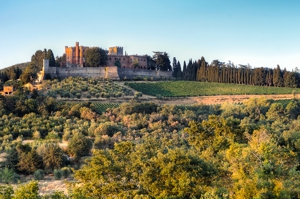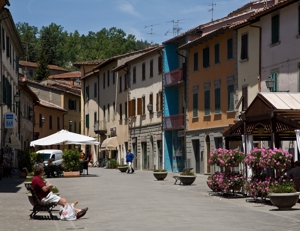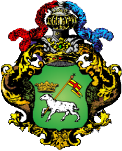Gaiole: a place of commercial exchanges since ancient times, in the '300, with the proclamation of the "League of Chianti", Gaiole became the capital of a third party. Located between Florence and Siena, it was often the subject of looting and assaults until 1555, the year of the definitive fall of Siena. The league resisted until 1776, as the third parties were transformed into Municipalities. The area of Gaiole is full of impressive castles: Brolio belonged to Ricasoli as Cacchiano. The latter was destroyed by the Aragonese in 1478 and rebuilt in 1530. Again: Monteluco, composed of two parts and placed on a hill, from which dominates the entire valley. To see: the Parish Church of S. Polo in Rosso, the Church of S. Giusto in Salcio, the castle of Meleto, Barbischio, the castle of Brolio, and much more.
* Pieve di San Marcellino
Characterized by the hedged façade of the Alberese tree, the apse is decorated with the primitive settlement; its dimensions are out of tune with those smaller than the other parts of the church, probably rebuilt during the fourteenth century.
* Parish Church of San Polo in Rosso, 12th century.
The name of the church is in a donation of 1070 and is referred to as Sancti Pauli scito Russo. Also in the bull dated 11 March 1103 issued by Pasquale II to the bishop Giovanni da Fiesole, we speak of this parish church. Remarkable.
* Pieve di San Giusto in Salcio
Of Romanesque structure, very beautiful and scenic even if largely rebuilt between 1926 and 1929.
* Parish Church of Santa Maria in Spaltenna
It dates back to 1030. In the, the parish church of San Pietro in Avenano (1102-1110) was transferred, which was renamed in Santa Maria to Spaltenna and transformed into a parish "munita". Definitively renamed by the Bishop of Fiesole in 1153 with its current name.
* Pieve di San Bartolomeo in Vertine
Two of his main works are now in the picture gallery of Siena: the Madonna dei Raccomandati, a youth work by Simone Martini, and the triptych by Bicci di Lorenzo depicting the "Madonna and Child with Saints Bartolomeo, Giovanni Evangelista, Maddalena and Antonio Abate (1430) ".
* Pieve di San Vincenti
In the 7th century its name was Basilica Sancti Vincenti in fundo Bomuspagi.
* Church of San Lorenzo in Ama
The territory of the church is mentioned in some parchments of the Abbey of Vallombrosa and of the Abbey of Coltibuono in the 12th century and in the 13th century and it was the possession of the Ricasoli family since 1100.
* Church of San Sano
It is dedicated to the Christian martyr Ansano, of the family Anicia of Rome, beheaded in 303 by order of the proconsul Lysia.
* Canonica di San Lorenzo in Mello
Inside it has a nave without an apse and a transverse arch that divides the presbytery area from the parsonage. At the side of the arch there are two zoomorphic heads, one is a pedator that represents a bull.
* Church of San Pietro in Avenano
It dates back to before the year 1000 and is known as a parish church in the 11th-12th centuries.
* Oratory of the Pianigiani
On the back wall of the Oratory there is a frescoed Madonna enthroned, surrounded by Angels and Saints, with the Child in her arms: the Child holds a little bird in his left hand and a precious stone in the right, symbol of the Good News. To the right of the Madonna is the fresco depicting St. Michael the Archangel that tramples the dragon and weighs the souls; on the other side Saint Francis with the Rule in his left hand, a Crucifix in his right hand and the Stigmata on his feet and hands. At the two side walls there are figures of saints: Sant'Antonio Abate, depicted with the fenced pig - in correspondence of this fresco has opened a crack - Saint Lucia, with the inscription Sca Lucia, which shows the symbols of their martyrdom, San Giovanni Battista, bearing the inscription: Ecce agnus Dei, San Pietro with a book in his hand, San Luca Evangelista with the inscription: S.co Lucha Vangelista, at the base of which is the name of the client (Luca Canpoli), Santa Mary Magdalene, fresco very deteriorated by a crack, with the inscription: S.ca M. Maddalena and a date (also deteriorated): 1496 All Chianti and Florentine Valdarno museums: Site
|



